On a map, it doesn’t look all that far. A quick jaunt up the freeway. A race across a sea of potato fields and a good section of the Idaho National Laboratory, where plans are in place to build a dozen modular nuclear reactors to help power some 36 western communities starting in less than a decade. Finally, there’s the run up the river valley to where the desert meets the Lemhi Range.
But once the rubber meets the road, anticipation slows everything down. The thought of a fat, foam hopper bouncing along a seam on the Little Lost River, only to be gobbled up by a tailwalking desert rainbow trout adds seemingly hours to the drive.
It’s a journey along Idaho’s fabled sinks drainages. Streams with names like Middle Creek, Camas Creek and Birch Creek run out of the Beaverhead, Lemhi and Lost River ranges along the Idaho-Montana border and across much of the eastern Idaho steppe, only to “sink” into the desert, leaving bone-dry stream bottoms behind as evidence that they ever ran wet all.
Some 200 years later, the water that courses through these streams will reemerge in the Thousand Springs area of southern Idaho, having percolated and moved through the Eastern Snake River Plain Aquifer that, if it was surface water, would be a lake about 170 miles long and twice as deep as Lake Erie.
The river first appears a good clip north of the village of Howe, which nestles up against the mountains at the mouth of the valley. You never really see the river, just a line of green willows off in the distance, a bright contrast to the taupe and browns of the late-summer scablands. Higher up, cottonwoods join in and shade the river’s flows, providing a cool canopy. Even on the hottest days of the year, and thanks to a significant contribution from icy springs and upwelling, the Little Lost runs cold and clear. Until it simply stops running at all.
To the north and east lies the Lemhi Range, Idaho’s driest mountains. To the West is the Lost River Range, home to the state’s highest peak, Mt. Borah, which, even in mid-August this year, still boasts a bit of snow along it’s 12,677-foot crest. Will it last until the weather chills and the first dusting of the new season arrives? That’s anybody’s guess.
As I dab floatant on the tan, foam hopper pattern, the real deal flits and buzzes around me. They aren’t big bugs. Summer here just doesn’t last long enough for hoppers to get finger-fat like they do lower down in the valley. In fact, a few willows and more than a few cottonwoods are starting to show the strain of shorter days and cooler nights—they aren’t quite yellow-gold, but they aren’t exactly green, either.
Fall is coming. Time is short. It’s hopper season on the high desert, and for dry-fly creek freaks like me, it’s the best time of the year.
As I step into the chill of the river, my first thought is one of position. The canopy is real, and it rests low to the water. Casting in here has always been a challenge, and I suspect that’s why the Little Lost doesn’t get a lot of pressure. It’s also far away from any substantive population center, too, so I’m sure that helps. It takes commitment to come this far and then be forced to knock the rust off your roll cast for an afternoon of fishing.
But when that first rainbow rises to a hopper, it’s worth it. It’s the rise of a naive fish (although they learn quickly) that’s seizing the opportunity grab a mouthful of protein that might only be around for a couple of weeks. The first frost will put the bugs down a bit, and the second one might kill hopper season for the year.
It’s a get-it-while-you-can brand of fly fishing, and my boots have trekked along the river’s course over the last two decades, usually showing up for the first time in early August and finally calling it quits for the season sometime in September when the surrounding hills are crawling with bow-season elk hunters and that first chill of fall leaves a glistening of frost on the tent.
Pointing my nose upstream, I see a likely run. The Little Lost is not the perfect trout stream. Once it leaves the confines of Sawmill Canyon and starts its course down the valley, it’s largely a straight pipe with a few precious bends and some undercut banks and scour pools that give fish a place to hang out. But I step into the river at a good place, giving me a handful of good spots—solid holding water with depth and some character—to fish over the course of the afternoon.
Behind me, willows and cottonwoods drape into the water. A backcast would have to be dead-on perfect. I’d have to improvise—it’s the kind of fishing those of us who ply small waters have come to appreciate. We’ve learned by doing.
Once, several years back, I took an old high-school buddy fly fishing on a small stream not far from Jackson, Wyoming. He’s a solid fly angler, but not one schooled on intimate creeks. He was having a hard time placing his fly under a willow overhang, so he asked me to show him.
With years of creeking under my belt, I flipped a hopper ahead and skipped it under the willows, where a fat cutthroat didn’t hesitate to eat it.
“Yeah,” my friend said as I reeled in the nice trout. “I don’t have that cast. How do you do it?”
I thought about it for a few seconds, and I replied, simply:
“I don’t know. I just do it.”
And that’s what fishing the Little Lost is all about. It’s the arena where all the practice pays off. The “octagon” of small-stream trout fishing. Enter at your own risk. You won’t leave intact.
If you’re like me, and you wade wet all summer, this is where the sage twigs, willow branches and wild roses chew at your shins and calves as you bounce from one pool to the next. The blood flows freely and it feels good when you step back into the river to let the cool water salve the scrapes and punctures. Battle wounds, proudly displayed. The price paid for the hookup, when a fish explodes under a hopper and takes to the air and then tries to wrap itself around every rootwad or lodge itself under every rock.
And when you’re done, and you’re back in the truck, soaked in summer sweat and guzzling greedily from the water bottle, you feel like you earned this day. Spent. Sated.
Until the sun comes up again the next day, and that first hopper lights on the windshield. Yesterday’s cuts have scabbed over. The fish are waiting.
It’s hopper season. Are you ready?



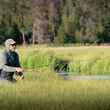


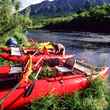








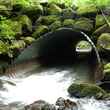
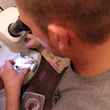




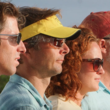








Comments